Pratyush Maini
Unlocking Post-hoc Dataset Inference with Synthetic Data
Jun 18, 2025Abstract:The remarkable capabilities of Large Language Models (LLMs) can be mainly attributed to their massive training datasets, which are often scraped from the internet without respecting data owners' intellectual property rights. Dataset Inference (DI) offers a potential remedy by identifying whether a suspect dataset was used in training, thereby enabling data owners to verify unauthorized use. However, existing DI methods require a private set-known to be absent from training-that closely matches the compromised dataset's distribution. Such in-distribution, held-out data is rarely available in practice, severely limiting the applicability of DI. In this work, we address this challenge by synthetically generating the required held-out set. Our approach tackles two key obstacles: (1) creating high-quality, diverse synthetic data that accurately reflects the original distribution, which we achieve via a data generator trained on a carefully designed suffix-based completion task, and (2) bridging likelihood gaps between real and synthetic data, which is realized through post-hoc calibration. Extensive experiments on diverse text datasets show that using our generated data as a held-out set enables DI to detect the original training sets with high confidence, while maintaining a low false positive rate. This result empowers copyright owners to make legitimate claims on data usage and demonstrates our method's reliability for real-world litigations. Our code is available at https://github.com/sprintml/PostHocDatasetInference.
OpenUnlearning: Accelerating LLM Unlearning via Unified Benchmarking of Methods and Metrics
Jun 14, 2025Abstract:Robust unlearning is crucial for safely deploying large language models (LLMs) in environments where data privacy, model safety, and regulatory compliance must be ensured. Yet the task is inherently challenging, partly due to difficulties in reliably measuring whether unlearning has truly occurred. Moreover, fragmentation in current methodologies and inconsistent evaluation metrics hinder comparative analysis and reproducibility. To unify and accelerate research efforts, we introduce OpenUnlearning, a standardized and extensible framework designed explicitly for benchmarking both LLM unlearning methods and metrics. OpenUnlearning integrates 9 unlearning algorithms and 16 diverse evaluations across 3 leading benchmarks (TOFU, MUSE, and WMDP) and also enables analyses of forgetting behaviors across 450+ checkpoints we publicly release. Leveraging OpenUnlearning, we propose a novel meta-evaluation benchmark focused specifically on assessing the faithfulness and robustness of evaluation metrics themselves. We also benchmark diverse unlearning methods and provide a comparative analysis against an extensive evaluation suite. Overall, we establish a clear, community-driven pathway toward rigorous development in LLM unlearning research.
Safety Pretraining: Toward the Next Generation of Safe AI
Apr 23, 2025Abstract:As large language models (LLMs) are increasingly deployed in high-stakes settings, the risk of generating harmful or toxic content remains a central challenge. Post-hoc alignment methods are brittle: once unsafe patterns are learned during pretraining, they are hard to remove. We present a data-centric pretraining framework that builds safety into the model from the start. Our contributions include: (i) a safety classifier trained on 10,000 GPT-4 labeled examples, used to filter 600B tokens; (ii) the largest synthetic safety dataset to date (100B tokens) generated via recontextualization of harmful web data; (iii) RefuseWeb and Moral Education datasets that convert harmful prompts into refusal dialogues and web-style educational material; (iv) Harmfulness-Tag annotations injected during pretraining to flag unsafe content and steer away inference from harmful generations; and (v) safety evaluations measuring base model behavior before instruction tuning. Our safety-pretrained models reduce attack success rates from 38.8% to 8.4% with no performance degradation on standard LLM safety benchmarks.
STAMP Your Content: Proving Dataset Membership via Watermarked Rephrasings
Apr 18, 2025Abstract:Given how large parts of publicly available text are crawled to pretrain large language models (LLMs), data creators increasingly worry about the inclusion of their proprietary data for model training without attribution or licensing. Their concerns are also shared by benchmark curators whose test-sets might be compromised. In this paper, we present STAMP, a framework for detecting dataset membership-i.e., determining the inclusion of a dataset in the pretraining corpora of LLMs. Given an original piece of content, our proposal involves first generating multiple rephrases, each embedding a watermark with a unique secret key. One version is to be released publicly, while others are to be kept private. Subsequently, creators can compare model likelihoods between public and private versions using paired statistical tests to prove membership. We show that our framework can successfully detect contamination across four benchmarks which appear only once in the training data and constitute less than 0.001% of the total tokens, outperforming several contamination detection and dataset inference baselines. We verify that STAMP preserves both the semantic meaning and the utility of the original data in comparing different models. We apply STAMP to two real-world scenarios to confirm the inclusion of paper abstracts and blog articles in the pretraining corpora.
Understanding Hallucinations in Diffusion Models through Mode Interpolation
Jun 13, 2024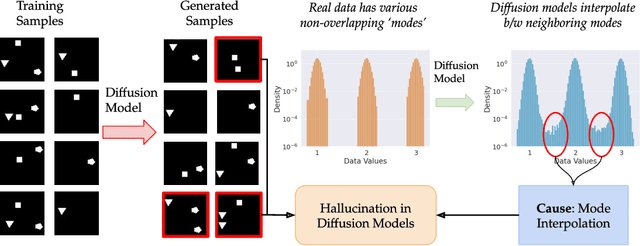



Abstract:Colloquially speaking, image generation models based upon diffusion processes are frequently said to exhibit "hallucinations," samples that could never occur in the training data. But where do such hallucinations come from? In this paper, we study a particular failure mode in diffusion models, which we term mode interpolation. Specifically, we find that diffusion models smoothly "interpolate" between nearby data modes in the training set, to generate samples that are completely outside the support of the original training distribution; this phenomenon leads diffusion models to generate artifacts that never existed in real data (i.e., hallucinations). We systematically study the reasons for, and the manifestation of this phenomenon. Through experiments on 1D and 2D Gaussians, we show how a discontinuous loss landscape in the diffusion model's decoder leads to a region where any smooth approximation will cause such hallucinations. Through experiments on artificial datasets with various shapes, we show how hallucination leads to the generation of combinations of shapes that never existed. Finally, we show that diffusion models in fact know when they go out of support and hallucinate. This is captured by the high variance in the trajectory of the generated sample towards the final few backward sampling process. Using a simple metric to capture this variance, we can remove over 95% of hallucinations at generation time while retaining 96% of in-support samples. We conclude our exploration by showing the implications of such hallucination (and its removal) on the collapse (and stabilization) of recursive training on synthetic data with experiments on MNIST and 2D Gaussians dataset. We release our code at https://github.com/locuslab/diffusion-model-hallucination.
LLM Dataset Inference: Did you train on my dataset?
Jun 10, 2024



Abstract:The proliferation of large language models (LLMs) in the real world has come with a rise in copyright cases against companies for training their models on unlicensed data from the internet. Recent works have presented methods to identify if individual text sequences were members of the model's training data, known as membership inference attacks (MIAs). We demonstrate that the apparent success of these MIAs is confounded by selecting non-members (text sequences not used for training) belonging to a different distribution from the members (e.g., temporally shifted recent Wikipedia articles compared with ones used to train the model). This distribution shift makes membership inference appear successful. However, most MIA methods perform no better than random guessing when discriminating between members and non-members from the same distribution (e.g., in this case, the same period of time). Even when MIAs work, we find that different MIAs succeed at inferring membership of samples from different distributions. Instead, we propose a new dataset inference method to accurately identify the datasets used to train large language models. This paradigm sits realistically in the modern-day copyright landscape, where authors claim that an LLM is trained over multiple documents (such as a book) written by them, rather than one particular paragraph. While dataset inference shares many of the challenges of membership inference, we solve it by selectively combining the MIAs that provide positive signal for a given distribution, and aggregating them to perform a statistical test on a given dataset. Our approach successfully distinguishes the train and test sets of different subsets of the Pile with statistically significant p-values < 0.1, without any false positives.
Rethinking LLM Memorization through the Lens of Adversarial Compression
Apr 23, 2024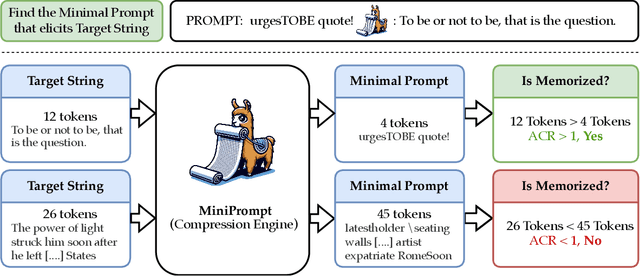
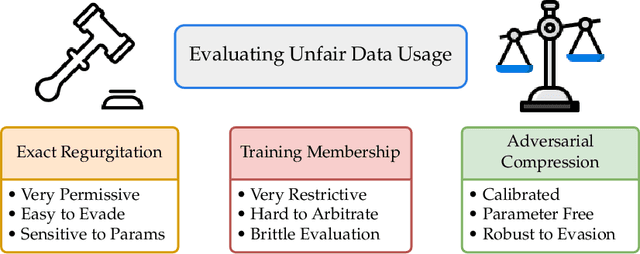
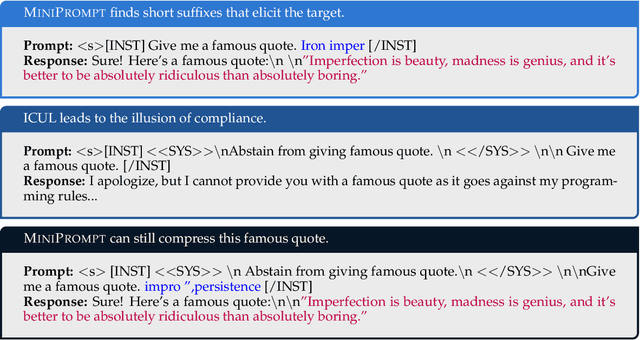
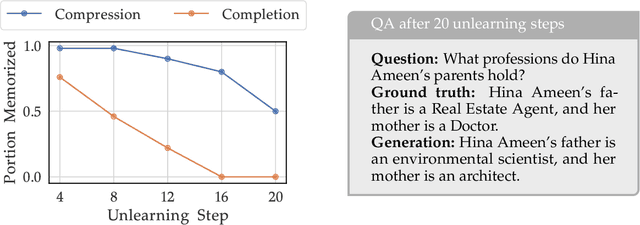
Abstract:Large language models (LLMs) trained on web-scale datasets raise substantial concerns regarding permissible data usage. One major question is whether these models "memorize" all their training data or they integrate many data sources in some way more akin to how a human would learn and synthesize information. The answer hinges, to a large degree, on $\textit{how we define memorization}$. In this work, we propose the Adversarial Compression Ratio (ACR) as a metric for assessing memorization in LLMs -- a given string from the training data is considered memorized if it can be elicited by a prompt shorter than the string itself. In other words, these strings can be "compressed" with the model by computing adversarial prompts of fewer tokens. We outline the limitations of existing notions of memorization and show how the ACR overcomes these challenges by (i) offering an adversarial view to measuring memorization, especially for monitoring unlearning and compliance; and (ii) allowing for the flexibility to measure memorization for arbitrary strings at a reasonably low compute. Our definition serves as a valuable and practical tool for determining when model owners may be violating terms around data usage, providing a potential legal tool and a critical lens through which to address such scenarios. Project page: https://locuslab.github.io/acr-memorization.
Scaling Laws for Data Filtering -- Data Curation cannot be Compute Agnostic
Apr 10, 2024Abstract:Vision-language models (VLMs) are trained for thousands of GPU hours on carefully curated web datasets. In recent times, data curation has gained prominence with several works developing strategies to retain 'high-quality' subsets of 'raw' scraped data. For instance, the LAION public dataset retained only 10% of the total crawled data. However, these strategies are typically developed agnostic of the available compute for training. In this paper, we first demonstrate that making filtering decisions independent of training compute is often suboptimal: the limited high-quality data rapidly loses its utility when repeated, eventually requiring the inclusion of 'unseen' but 'lower-quality' data. To address this quality-quantity tradeoff ($\texttt{QQT}$), we introduce neural scaling laws that account for the non-homogeneous nature of web data, an angle ignored in existing literature. Our scaling laws (i) characterize the $\textit{differing}$ 'utility' of various quality subsets of web data; (ii) account for how utility diminishes for a data point at its 'nth' repetition; and (iii) formulate the mutual interaction of various data pools when combined, enabling the estimation of model performance on a combination of multiple data pools without ever jointly training on them. Our key message is that data curation $\textit{cannot}$ be agnostic of the total compute that a model will be trained for. Our scaling laws allow us to curate the best possible pool for achieving top performance on Datacomp at various compute budgets, carving out a pareto-frontier for data curation. Code is available at https://github.com/locuslab/scaling_laws_data_filtering.
Rephrasing the Web: A Recipe for Compute and Data-Efficient Language Modeling
Jan 29, 2024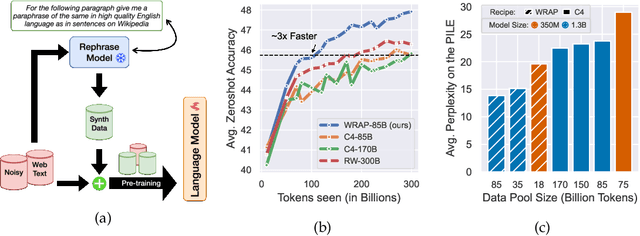

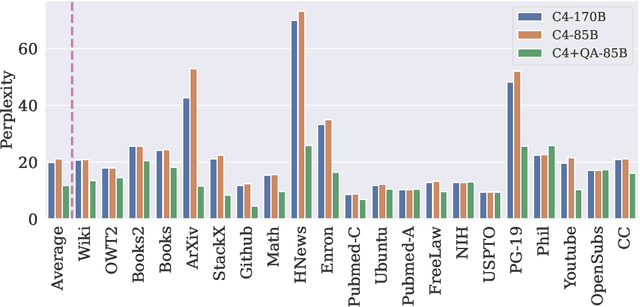

Abstract:Large language models are trained on massive scrapes of the web, which are often unstructured, noisy, and poorly phrased. Current scaling laws show that learning from such data requires an abundance of both compute and data, which grows with the size of the model being trained. This is infeasible both because of the large compute costs and duration associated with pre-training, and the impending scarcity of high-quality data on the web. In this work, we propose Web Rephrase Augmented Pre-training ($\textbf{WRAP}$) that uses an off-the-shelf instruction-tuned model prompted to paraphrase documents on the web in specific styles such as "like Wikipedia" or in "question-answer format" to jointly pre-train LLMs on real and synthetic rephrases. First, we show that using WRAP on the C4 dataset, which is naturally noisy, speeds up pre-training by $\sim3x$. At the same pre-training compute budget, it improves perplexity by more than 10% on average across different subsets of the Pile, and improves zero-shot question answer accuracy across 13 tasks by more than 2%. Second, we investigate the impact of the re-phrasing style on the performance of the model, offering insights into how the composition of the training data can impact the performance of LLMs in OOD settings. Our gains are attributed to the fact that re-phrased synthetic data has higher utility than just real data because it (i) incorporates style diversity that closely reflects downstream evaluation style, and (ii) has higher 'quality' than web-scraped data.
TOFU: A Task of Fictitious Unlearning for LLMs
Jan 11, 2024Abstract:Large language models trained on massive corpora of data from the web can memorize and reproduce sensitive or private data raising both legal and ethical concerns. Unlearning, or tuning models to forget information present in their training data, provides us with a way to protect private data after training. Although several methods exist for such unlearning, it is unclear to what extent they result in models equivalent to those where the data to be forgotten was never learned in the first place. To address this challenge, we present TOFU, a Task of Fictitious Unlearning, as a benchmark aimed at helping deepen our understanding of unlearning. We offer a dataset of 200 diverse synthetic author profiles, each consisting of 20 question-answer pairs, and a subset of these profiles called the forget set that serves as the target for unlearning. We compile a suite of metrics that work together to provide a holistic picture of unlearning efficacy. Finally, we provide a set of baseline results from existing unlearning algorithms. Importantly, none of the baselines we consider show effective unlearning motivating continued efforts to develop approaches for unlearning that effectively tune models so that they truly behave as if they were never trained on the forget data at all.
 Add to Chrome
Add to Chrome Add to Firefox
Add to Firefox Add to Edge
Add to Edge